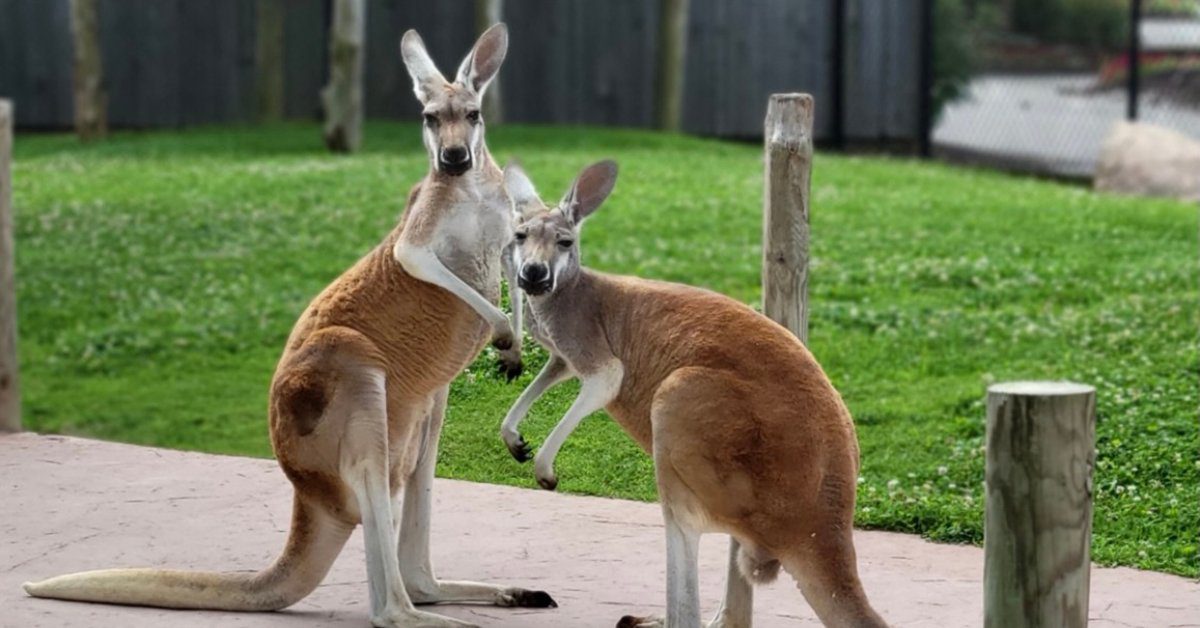
Australia has some very unique animals. It is home to the only two extant monotremes (egg-laying mammals): the platypus and the echidna, also called the spiny anteater (although the echidna also inhabits New Guinea). It also has all but three marsupial orders living there, the exceptions being Didelphimorphia (which includes South American opossums and the Virginia possum), Paucituberculata (the caenolestid “rat” or “shrew” opossums), and Microbiotheria (the monito del monte Dromiciops gliroides).
Some of Australia’s marsupials are iconic, such as kangaroos, koalas, and wombats. They instantly bring to mind their Australian homeland. There are also large flightless birds native to Australia: the emu, cassowary, and the smallest species of penguin, aptly named the little penguin or the fairy penguin (they are also native to New Zealand). The infamous Tasmanian devil (which looks nothing like the Warner Brothers cartoon character) lives in Tasmania and has been reintroduced to the Australian mainland. The (likely) extinct Thylacine, also called the Tasmanian tiger, once called Tasmania and mainland Australia home. Just this brief listing of animals makes clear that Australian fauna is vastly different from what we see in North America, Europe, and Asia.
For creation biologists, paleontologists, and researchers, one of the most frequently asked questions concerning animal biogeography is, Why Australia’s animals are so unique? And the second is then, How did they get there? Perhaps the frequent skeptical questions, Did kangaroos hop all the way to Australia? and, Why aren’t there marsupial fossil trails from Turkey to Australia? brings this into focus. Since Scripture states that all air-breathing terrestrial animal kinds left the ark and repopulated the world, creation researchers need to have viable answers to the question of Australia’s fauna.
Why Don’t We Find Marsupial Fossils on a Trail from Ararat to Australia?
We need to keep in mind that terrestrial animals are not readily fossilized, especially ones that did not frequent coastal plains, bogs, tundra, or congregate near rivers. The vast majority of post-flood mammalian and bird fossils are found in such areas or in traps like tar pits and salt lick quagmires. Take for example the passenger pigeon, which is believed to have had flocks in the 4–5 billion range for at least a few thousand years in North America. They went extinct in 1914, mostly due to overhunting but possibly with disease aiding the swift decline. In any event, of these estimated hundreds of billions of animals over the course of their existence, how many “fossils” of them have been found? A little more that 130—yes 130 total bones.1 And most of these are leg bones that have been recovered from caves,2 lakeshores, and the LaBrea Tar Pits (in other words, the few environments where preservation would be most favorable).3
Now, if an animal population numbering in the hundreds of billions would yield 130 fossils, how many would we expect of an initial kangaroo “kind” population of two to yield as they migrated from the Turkey/Armenia/Iraq region over the course of, say, 100–200 years?
Now, if an animal population numbering in the hundreds of billions would yield 130 fossils, how many would we expect of an initial kangaroo “kind” population of two to yield as they migrated from the Turkey/Armenia/Iraq region over the course of, say, 100–200 years? Probably at most a few, and the area where they were traveling from and to are not the ideal environments for fossilization. Also worth noting, although kangaroos only currently live in Australia, some of the wallabies and tree kangaroos live in New Guinea as well as Australia. It is well known that rafting and island-hopping allowed some marsupials (and unique flightless birds like the cassowary) from New Guinea to “colonize” Australia, so to posit the same for the kangaroo is quite logical. Additionally, other unique Australian birds, such as the kookaburra and tawny frogmouth (as well as many others), could have easily flown there from neighboring islands. For example, marbled frogmouths can be found on New Guinea as well as mainland Australia.4
Ironically, Darwinists are always saying that some type of transitional fossil exists between this lineage or that, but that the fossils just haven’t been found yet; so why can’t creationists make the same claim regarding ark migrants? The absence of evidence of marsupial fossils from Ararat to Australia is not “evidence of absence,” just as the absence of evidence of fossils of marsupials in other areas doesn’t mean they didn’t live there in the past. But even the absence of evidence argument is wearing thin as practically every few years a new post-flood marsupial find turns up in places where we would expect to find animals radiated out from Ararat. Post-flood Asian marsupial fossils have been found in the Eocene, Oligocene, and Miocene strata of Asia. Asiadelphis was discovered in the Oligocene of Kazakhstan (1992), reported didelphids (Siamoperadectes) were found in the Miocene of Thailand (1992), and an Asiadelphid-like opossum was found in the Middle Eocene of China (1996). In 2001, a didelphid tooth was discovered in the early or mid-Eocene in Pakistan. In 2002, another didelphid was discovered in China, and in 2004, two newly reported genera, Indodelphis and Jaegaeria were discovered in India.5
Perhaps one day the fossil record will turn up Armenian kangaroo fossils. While that hasn’t happened yet, there have been metatherian fossils found in Turkey.6 Metatherians are considered ancestral to marsupials by evolutionary biologists, but creation baraminologists just consider most of them marsupials that speciated after leaving the ark (although some metatherians likely are their own biblical kind). The metatherians found in Turkey had migrated west about 1,172 km (728 miles) from the Ararat region by the early post-flood period, conventionally dated (hereafter abbreviated to CD) to 43 Ma, or middle Eocene. Of the four named metatherian fossils found in Turkey, one (Thylacotinga bartholomaii) has also been found in Australia but dated earlier to the early Eocene (CD 54.6 Ma), so even earlier post-flood.7
When and How Did Most of Australia’s Animals Arrive?
Most evolutionary biologists believe that Australia’s marsupials evolved there. Yet Cretaceous fossil metatherians (mostly marsupials) are not found in Australia. They are found only in Europe, Asia, and North America. A Science journal article said this:
Living marsupials are restricted to Australia and South America (which were part of the supercontinent Gondwana); North American opossums are recent immigrants to the continent. In contrast, metatherian fossils from the Late Cretaceous are exclusively from Eurasia and North America (which formed the supercontinent Laurasia). This geographical switch remains unexplained.8
The Cretaceous metatherians (whether marsupial or their own biblical kind) all died in the flood. Representatives of their kinds all came aboard the ark and dispersed from Ararat. As mentioned above both extant monotremes and all but three orders of marsupials ended up in Australia (or neighboring regions such as New Guinea and Indonesia). The flood (which wiped out and buried the single-continent Rodinia’s pre-flood marsupials except those taken aboard the ark) and post-flood dispersal and migration of the ark’s marsupials explain the “geographical switch” mentioned above but still leaves us with the puzzle of why monotremes and most marsupials “headed southeast” towards Australia. But before we discuss this question, let’s examine the when and how of Australian fauna.
While it is natural to think of land bridges being used as migratory routes during the Ice Age, and we know that two such existed between mainland Asia and Indonesia, as well as Australia and New Guinea, it appears that most Australian animals had migrated there prior to the Ice Age, or before the land bridges were exposed. Most fossil marsupials date to the Late Oligocene (CD 27–23 Ma) or early Miocene (CD 23–20 Ma).9 The primary method proposed by AiG and the Ark Encounter for getting kangaroos and other marsupials to Australia is rafting. According to signage at the Ararat Zoo (at the Ark Encounter):
Plant material ripped-up during the Flood would have formed enormous floating rafts of debris across many ocean surfaces, perhaps persisting for many decades.
Shortly before we find the earliest examples of these animals in the fossil record, continental movements caused ocean currents entering the Indian Ocean to circle past India to Africa and Australia.
Surfing the ocean currents on rafts would have greatly accelerated the post-Flood dispersion of these animals, helping them survive in a remade world.
Of course, there are some animals that can swim, fly, or island-hop (which may have also included rafting) over vast distances, and accidental hitchhiking or deliberate transport by humans can also come into play, especially for late-arriving animals.
Of course, there are some animals that can swim, , fly, or island-hop (which may have also included rafting) over vast distances, and accidental hitchhiking or deliberate transport by humans can also come into play, especially for late-arriving animals. A select few Australian animals could have used the land bridges during the Ice Age or could have been taken as food sources by people. This may have been the case with the cassowary (which the Papuan people semi-domesticated)10 and emu. Additionally the oldest emu fossils are found later in the rock strata (Middle Eocene CD 15 Ma),11 and the earliest cassowary fossil is from even later, with one arguable specimen from the middle Pliocene (CD 4 Ma) but most dating from the late Pleistocene (CD 26,000–10,000 years BP).12 The cassowary, being semi-domesticated, now lives in Australia and New Guinea, but is a late arrival to Australia. The Sahul land bridge, which connected New Guinea and Australia during the ice age, was probably the route that cassowaries took via that land bridge or from human transport.
Why Australia?
We now return to the question of why all extant monotremes and most marsupials migrated from Ararat to Australia (and Indonesia, New Guinea, and surrounding islands). There are a few hypotheses in the creation literature as to why marsupials migrated towards the southeast from Ararat. The first is the competition model. It is well known that most marsupials can’t compete with placental animals, partly due to their slower speed compared to most placental carnivores and also because their young take so long to develop. This would make them especially prone to predation by large carnivorous animals like big cats, bears, and wolves—and predation upon females would also kill the next generation at the same time.13 In addition, some post-mating death of males is reported for several species of dasyurid marsupials, most notably Parantechinus apicalis and Dasyurus hallucatus14 as well as the genus Antechinus,15 which can severely limit population expansion compared to placentals.
Perhaps competition from placentals drove marsupials to migrate away from the ark in different directions than placentals. Marsupials then gained an early foothold in Australia and South America, and without competition from placentals, they thrived in those locations.16 Looking at most other animal kinds’ migration patterns from the ark, it seems that the bigger predators primarily migrated west, north or due south, into Asia, Europe, and Africa, or over the Bering land bridge to North America. While most marsupials are not “fast” animals, the females can delay pregnancy during stressful times and can more readily move when pregnant due to their babies being so small (starting out about the size of a jelly bean) and nestled inside a pouch. Most are herbivores or insectivores and so can forage as they migrate, especially in the lush early post-flood years.
We also need to remember that God told the animals to be fruitful and multiply (Genesis 8:17). It seems infeasible for God to desire that all the animals multiply and then unleash the carnivores on the herbivores right away.
Whether their choice of direction was due to potential predators taking off in different directions or whether they migrated from the ark first is unknowable. But most carnivores would have had little incentive to chase down marsupials when there were likely pools of stranded fish in every remnant pond left over from the flood. Additionally, many carnivores are also insectivores and may have had a ready stash of insects to eat. Plus some carnivores today are more omnivorous than carnivorous, and so could have had more options than just chasing down a wombat. Monotremes, because they are egg-layers, could likewise have been susceptible in early populations to carnivores and may have migrated along the same paths as marsupials. We also need to remember that God told the animals to be fruitful and multiply (Genesis 8:17). It seems infeasible for God to desire that all the animals multiply and then unleash the carnivores on the herbivores right away. It is possible that God either delayed carnivorous tendencies or provided enough other meat (stranded fish, eels, and crustaceans, for example) that the herbivores could migrate away and establish viable populations.
The second model is that terrain may have also played an important factor. While there is no entirely smooth non-mountainous terrain between Ararat and Southeast Asia, one of the least mountainous is the trek from Ararat southeast to Syria and then on to the Arabian Peninsula where they could have migrated into Africa, or crossed over into Iran and migrated toward India. From any of those three points, rafting could have easily occurred as several ocean currents from Somalia, Arabia, and India circle towards Indonesia, New Guinea, and Australia (see Fig. 1 below). It would have been shortly after the initial migration from Ararat that post-flood hypercanes, river floods, and other local catastrophes would have been occurring frequently, and all of these would have facilitated rafting by sweeping mats of vegetation off the continents and carrying them (and any animal passengers) out to sea.
Frank L. Marsh, a creationist pioneer in developing and promoting the concept of baraminology, also had some insight into biogeography. To forestall the mocking “Did kangaroos hop all the way to Australia?” skeptical questions, Marsh replied with a well-reasoned (and biblically feasible) migration scenario:
The journeys from the mountains of Ararat to their present habitats were made in an intermittent fashion, most generations sending representatives a little farther from the original home. The presence of tapirs today only in South America and the Malayan islands, opposite sides of the earth, is indicative of the fact that animals migrated in more than one direction. The creationist holds that there is no reason for believing that this distribution of animals was accomplished by any other processes than those employed in distribution today. . . . Increase in numbers of individuals of any one kind causes a necessity for spreading outwards toward the horizon in search of food and homes. . . . Their arrival in new areas may be a result of deliberate individual endeavor or it may be that they arrive as wave-tossed survivors of some coastal accident.17
Conclusion
The aforementioned “waves of migration” statement seems to be quite applicable to the question of how Australian fauna ended up there. Combining some initial overland migration from Ararat, river rafting in some cases, island hopping, swimming, flying (for creatures who can), and vegetation mat rafting (and possibly land bridges for the ice age arrivals), we have the mechanisms for marsupials and monotremes to reach Australia from Ararat within 100–200 years. The uniqueness of Australian fauna likely resulted from a departure away from most other predators via a providential, less-arduous terrain route and the post-flood local and regional catastrophes that would have facilitated transport from coastal areas to Australia via vegetative mat rafting.



















